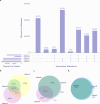This is a preprint.
The Impact of Evolving Endometriosis Guidelines on Diagnosis and Observational Health Studies
- PMID: 39763562
- PMCID: PMC11702737
- DOI: 10.1101/2024.12.13.24319010
The Impact of Evolving Endometriosis Guidelines on Diagnosis and Observational Health Studies
Abstract
Study question: Do recent changes in European Society of Human Reproduction and Embryology (ESHRE) clinical guidelines result in more comprehensive diagnosis of women with endometriosis?
Summary answer: The latest shift in clinical guidelines results in diagnosis of more women with endometriosis but current ESHRE diagnostic criteria do not capture a sizable percentage of women with the disease.
What is known already: Historically, laparoscopy was the gold standard for diagnosing endometriosis, a complex gynecological condition marked by a heterogeneous set of symptoms that vary widely among women. More recently, changes in clinical guidelines have shifted to incorporate imaging-based approaches such as transvaginal sonography and magnetic resonance imaging.
Study design size duration: Retrospective, observational cohort study of women aged 15-49 years diagnosed with endometriosis in the United States (US) between January 1, 2013, and December 31, 2023.
Participants/materials setting methods: Data sources include US insurance claims data from the Merative™ MarketScan® Commercial Database (CCAE), Merative™ MarketScan® Multi-State Medicaid Database (MDCD), Optum® de-identified Electronic Health Record dataset (Optum® EHR), and electronic health record (EHR) data from a large academic medical center in New York City (CUIMC EHR). To examine the potential impact of expanding clinical criteria for the diagnosis of endometriosis, we validated and compared five cohort definitions based on different sets of diagnostic guidelines involving combinations of surgical confirmation, diagnostic imaging, guideline-recognized symptoms, and other symptoms commonly reported among women with endometriosis. We performed pairwise comparisons between cohorts and applied Bonferroni corrections to account for multiple comparisons.
Main results and the role of chance: We identified 491,048 women with a diagnosis of endometriosis across the CCAE, MDCD, Optum EHR, and CUIMC EHR datasets. Each cohort definition demonstrated strong positive predictive value (0.84-0.96), yet only 15-20% of cases were identified by all 5 cohort definitions. Women diagnosed with endometriosis based on imaging and symptoms were three years younger, on average, than women with a diagnosis based on surgical confirmation (mean age = 35 years [SD = 9] vs 38 years [SD = 8]; p<0.001). Women in cohorts based only on symptoms were two years younger than those based on surgery (36 years [SD = 8] vs 38 years [SD = 8]; p<0.001). More than one-fourth of cases presented with endometriosis-related symptoms but lacked surgical or imaging-related documentation required by ESHRE guideline criteria. Pain was reported among nearly all women with endometriosis. Abdominal pain and pain in the pelvis were the most prevalent (ranging from 69% to 90% of women in each cohort). Among approximately 2-5% of all endometriosis cases (14,795 total), women presented with pelvic and/or abdominal pain but none of the other symptoms noted in clinical guidelines.
Limitations reasons for caution: Our study has potential biases associated with documentation practices and secondary data use of insurance claims and EHR data. Further, the phenotyping algorithms used rely on clinical codes that do not necessarily capture all ESHRE diagnostic criteria for endometriosis and may not be generalizable to women with atypical presentation of endometriosis.
Wider implications of the findings: High positive predictive value among all five cohort definitions despite poor overlap among cases identified illustrates both the heterogeneous presentation of the disease and importance of expanding diagnostic criteria. For example, cohorts derived from updated guidelines identified younger patients at time of diagnosis. Women diagnosed based on imaging had higher rates of emergency room visits while patients diagnosed via laparoscopy had a larger number of hospitalizations. The substantial number of cases with pelvic and/or abdominal pain but none of the other symptoms noted in clinical guidelines underscores the continued need for improved access to timely and appropriate care, particularly among those with non-classical symptoms, different care-seeking patterns, or lack of available surgical intervention.
Keywords: clinical guidelines; diagnosis; endometriosis; imaging; laparoscopy.
Conflict of interest statement
Conflict of Interest EAV, AO, FJD, and PBR are employees of Janssen Research and Development, LLC and shareholders of Johnson & Johnson (J&J) stock. The remaining authors report no conflict of interest.
Figures






References
-
- Dunselman G, Vermeulen N, Becker C, et al. ESHRE guideline: management of women with endometriosis. Human reproduction. 2014;29(3):400–412. - PubMed
Publication types
Grants and funding
LinkOut - more resources
Full Text Sources
Research Materials
